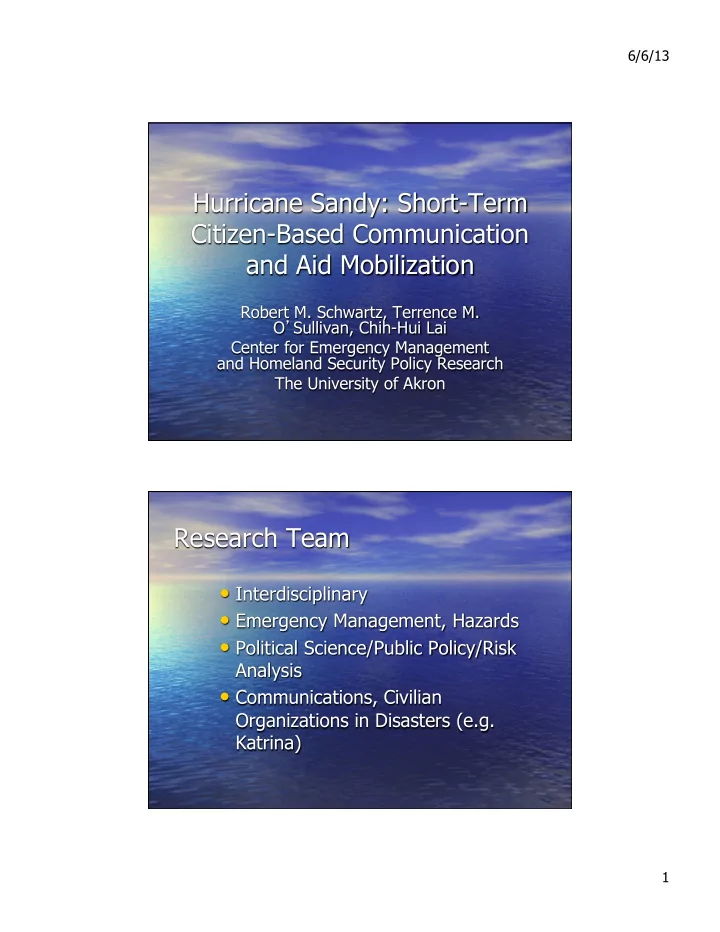

6/6/13 Hurricane Sandy: Short-Term Citizen-Based Communication and Aid Mobilization Robert M. Schwartz, Terrence M. O ’ Sullivan, Chih-Hui Lai Center for Emergency Management and Homeland Security Policy Research The University of Akron Research Team • Interdisciplinary • Emergency Management, Hazards • Political Science/Public Policy/Risk Analysis • Communications, Civilian Organizations in Disasters (e.g. Katrina) 1
6/6/13 Introduction • Examine phenomenon and scale of ad-hoc, local, citizen-based disaster communication, decision-making, and aid mobilization Disaster Research Center 2x2 Organization Typology • Structure (old, new) and Tasks (routine, non-routine) • Established (e.g., fire department) • Expanding (e.g., Red Cross) • Extending (e.g., church groups) • Emergent (new structure and tasks – especially volunteer-based) 2
6/6/13 Research Questions • What were the major types of citizen response groups that emerged following Hurricane/Superstorm Sandy? Why/How did they emerge? • How did the emergent groups communicate and coordinate with the affected communities? • Whether and how did emergent groups collaborate with other extending and emergent groups? Research Questions • In the communities where emergent groups were involves, how did the demographic/socioeconomic differences manifest themselves in acute need for assistance and the supply of those services? 3
6/6/13 Additional Research Questions • How did emergent groups use different types of media, including face-to-face, social media, radio, television, cell phones to communicate and coordinate within and across emergent and extending groups Follow-up Research Questions • What were the differences in the type of aid received (cleanup, food, water, shelter, power, fuel) from emergent groups in different phases of disaster response? • What is the role of these groups in different phases (emergency, recovery, and sustainability/ preparedness) of disaster response? 4
6/6/13 Methods • Mixed-methods • Qualitative case study • Quantitative analysis of field data Data Sources • Interviews • Snowball sampling • Internet (websites, blogs, discussion forums, Twitter, Facebook) 5
6/6/13 Preliminary Results Various Groups Identified (examples) – Churches, civic groups (extending) – Occupy Sandy Relief (emergent/hybrid) – People ’ s Relief – Red Hook Initiative Areas of Interviews – Rockaways – Brooklyn – Coney Island – New Jersey Preliminary Results • Social media acted as magnifier for communication and capabilities of both extending and emerging groups • Both seemed able to absorb far greater numbers of individual volunteers than would be usual • Possible model for future citizens organization resilience– for both prep and response 6
6/6/13 Citizen Organization Potential Photos by Terry O’Sullivan (2012) Extending groups Individual volunteers Hybrid Emergent and Extending groups Citizen Organization Potential Before Photo by Lev Tobias (2012) (520 Clinton St. Brooklyn Used with permission Church 2-3 days or so after storm) 7
6/6/13 Citizen Organizational Potential After (520 Clinton St. Church 2 weeks or so after storm: A functioning warehouse distro center) Photo by Lev Tobias (2012) Used with permission Future Research: “ Rest of the Story ” • Assess importance of early vs. later volunteer efforts for resilience • Better integration of communication among volunteer and established (govt) and expanding (Red Cross) • Recovery and contribution of volunteer emergent groups for future disaster resilience 8
6/6/13 Future Research: “ Rest of the Story ” • Survey with Citizens • Focus groups, interviews – Group leaders – Individual volunteers – Community members • Potential research collaborations Acknowledgments • NSF CMMI-1324180 • Volunteers and interviewees 9
6/6/13 Contact • Rob Schwartz: rms73@uakron.edu • Terry O’Sullivan: tmo@uakron.edu 10
Recommend
More recommend